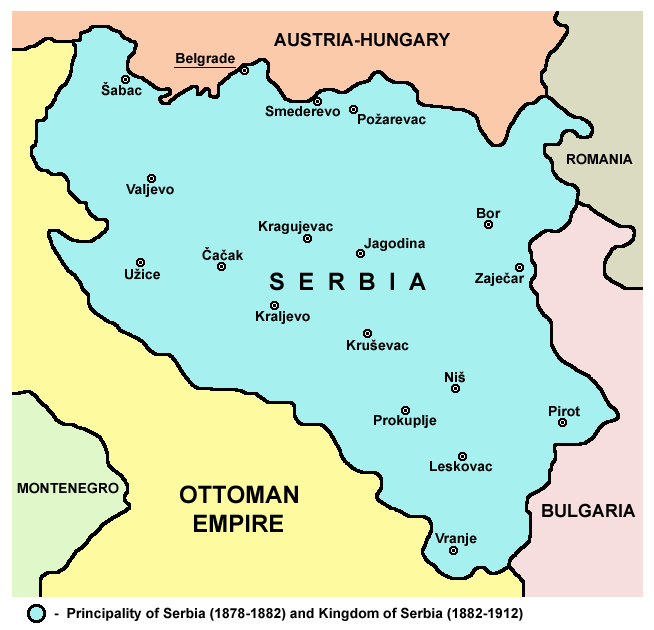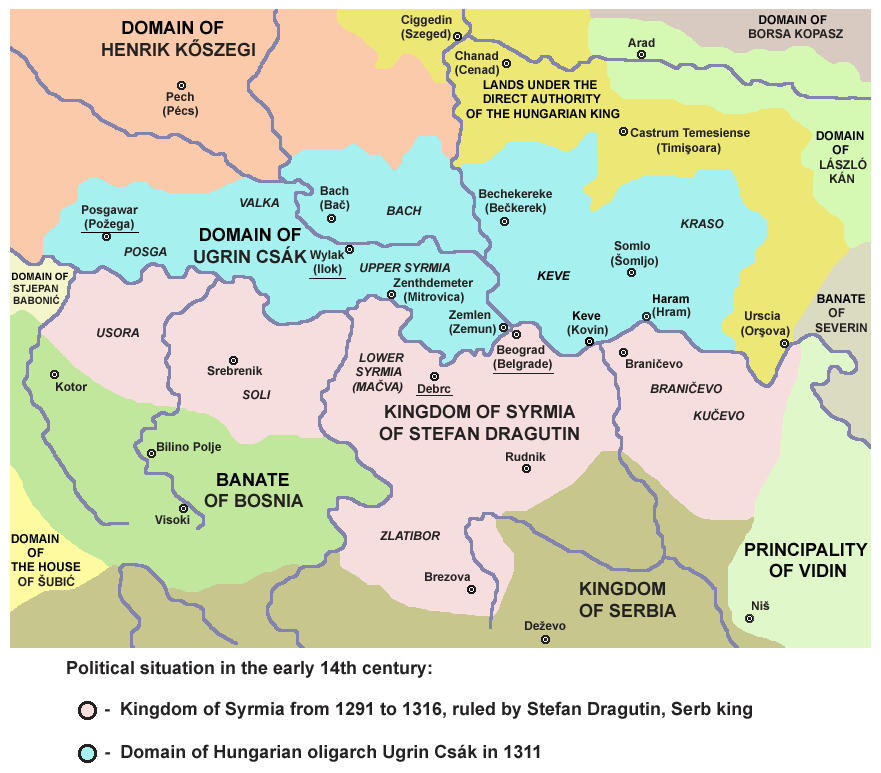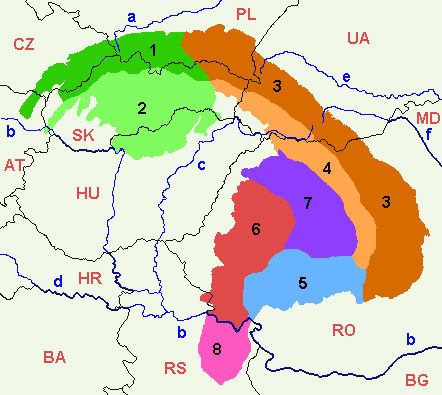|
Central Serbia
Central Serbia ( sr, централна Србија / centralna Srbija), also referred to as Serbia proper ( sr, link=no, ужа Србија / uža Srbija), is the region of Serbia lying outside the autonomous province of Vojvodina to the north and the disputed territory of Kosovo to the south. Central Serbia is a term of convenience, not an administrative division of Serbia as such, and does not have any form of separate administration. Broadly speaking, Central Serbia is the historical core of modern Serbia, which emerged from the Serbian Revolution (1804–17) and subsequent wars against the Ottoman Empire. In the following century, Serbia gradually expanded south, acquiring South Serbia, Kosovo, Sandžak and Vardar Macedonia, and in 1918 – following the unification and annexation of Montenegro and unification of Austro-Hungarian areas left of the Danube and Sava (Vojvodina) – it merged with other South Slavic territories into the Kingdom of Yugoslavia. The curren ... [...More Info...] [...Related Items...] OR: [Wikipedia] [Google] [Baidu] |
List Of Sovereign States
The following is a list providing an overview of sovereign states around the world with information on their status and recognition of their sovereignty. The 206 listed states can be divided into three categories based on membership within the United Nations System: 193 UN member states, 2 UN General Assembly non-member observer states, and 11 other states. The ''sovereignty dispute'' column indicates states having undisputed sovereignty (188 states, of which there are 187 UN member states and 1 UN General Assembly non-member observer state), states having disputed sovereignty (16 states, of which there are 6 UN member states, 1 UN General Assembly non-member observer state, and 9 de facto states), and states having a special political status (2 states, both in free association with New Zealand). Compiling a list such as this can be a complicated and controversial process, as there is no definition that is binding on all the members of the community of nations conce ... [...More Info...] [...Related Items...] OR: [Wikipedia] [Google] [Baidu] |
Sava
The Sava (; , ; sr-cyr, Сава, hu, Száva) is a river in Central and Southeast Europe, a right-bank and the longest tributary of the Danube. It flows through Slovenia, Croatia and along its border with Bosnia and Herzegovina, and finally through Serbia, feeding into the Danube in its capital, Belgrade. The Sava forms the main northern limit of the Balkan Peninsula, and the southern edge of the Pannonian Plain. The Sava is long, including the Sava Dolinka headwater rising in Zelenci, Slovenia. It is the largest tributary of the Danube by volume of water, and second-largest after the Tisza in terms of catchment area () and length. It drains a significant portion of the Dinaric Alps region, through the major tributaries of Drina, Bosna, Kupa, Una, Vrbas, Lonja, Kolubara, Bosut and Krka. The Sava is one of the longest rivers in Europe and among the longest tributaries of another river. The population in the Sava River basin is estimated at 8,176,000, and is s ... [...More Info...] [...Related Items...] OR: [Wikipedia] [Google] [Baidu] |
Mačva
Mačva ( sr-Cyrl, Мачва, ; hu, Macsó) is a geographical and historical region in the northwest of Central Serbia, on a fertile plain between the Sava and Drina rivers. The chief town is Šabac. The modern Mačva District of Serbia is named after the region, although the region of Mačva includes only the northern part of this district. A small northern part of Mačva region is in the Autonomous Province of Vojvodina, in the Syrmia District. Name The region is named after a town of Mačva, which existed in the Medieval Ages near the river Sava. In the past, the region was also known as ''Lower Srem'', while the neighbouring region on the northern bank of the river Sava (present-day Srem) was known as ''Upper Srem''. In Serbian Cyrillic, the region is known as Мачва, in Serbian Latin, Bosnian and Croatian as ''Mačva'', in Hungarian as ''Macsó'' or ''Macsóság'', in Turkish as ''Maçva'', and in German as ''Matschva''. History Throughout history, the region ... [...More Info...] [...Related Items...] OR: [Wikipedia] [Google] [Baidu] |
Šumadija
Šumadija (, sr-Cyrl, Шумадија) is a geographical region in the central part of Serbia. The area used to be heavily covered with forests, hence the name (from ''šuma'' 'forest'). The city of Kragujevac is the administrative center of the Šumadija District in the Šumadija and Western Serbia statistical region. The region is very fertile, and it is known for its extensive fruit production (apples, grapes, plums, etc.). Name ''Šumadija'' received its name from the dense and impassable forests which covered the region, particularly in the 16th and 17th centuries. These forests were preserved until the early 19th century; they are mentioned in literature and tradition. Bertrandon de la Broquière (1400–1459) passed through Serbia, on the road from Palanka to Belgrade he "passed through very large forests". During the reign of Prince Miloš (1817–1839), Serbia was covered with dense forests, through which "no one could walk through, let alone with horse". When Alp ... [...More Info...] [...Related Items...] OR: [Wikipedia] [Google] [Baidu] |
Balkan Mountains
The Balkan mountain range (, , known locally also as Stara planina) is a mountain range in the eastern part of the Balkan Peninsula in Southeastern Europe. The range is conventionally taken to begin at the peak of Vrashka Chuka on the border between Bulgaria and Serbia. It then runs for about , first in a south-easterly direction along the border, then eastward across Bulgaria, forming a natural barrier between the northern and southern halves of the country, before finally reaching the Black Sea at Cape Emine. The mountains reach their highest point with Botev Peak at . In much of the central and eastern sections, the summit forms the watershed between the drainage basins of the Black Sea and the Aegean. A prominent gap in the mountains is formed by the sometimes narrow Iskar Gorge, a few miles north of the Bulgarian capital, Sofia. The karst relief determines the large number of caves, including Magura, featuring the most important and extended European post-Palaeolithic c ... [...More Info...] [...Related Items...] OR: [Wikipedia] [Google] [Baidu] |
Serbian Carpathians
Serbian Carpathians ( sr, / ) is a mountain range in eastern Central Serbia, located in Central Europe. It presents an extension of proper Carpathian Mountains across the Danube, connecting them with the Balkan Mountains in the southeast. They stretch in north-south direction in eastern Serbia, east of the Great Morava valley and west of the White Timok Valley and north of the Nišava Valley. The mountains are 800–1500 m high, and dominated by karst limestone geologic features, the highest one being Rtanj Mountain (1,565 m). Definitions Under the strict definition (as defined by the Serbian Academy of Sciences and Arts and adopted by the Carpathian Convention), Serbian part of the Carpathian Mountains covers only 732 km², or less than 1% of the total Carpathian area. That part encompasses the southern bank of the Iron Gate and the area of Đerdap National Park. The extreme points of so defined Carpathian area in Serbia are Tekija in the north, in the south, Go ... [...More Info...] [...Related Items...] OR: [Wikipedia] [Google] [Baidu] |
Dinaric Alps
The Dinaric Alps (), also Dinarides, are a mountain range in Southern and Southcentral Europe, separating the continental Balkan Peninsula from the Adriatic Sea. They stretch from Italy in the northwest through Slovenia, Croatia, Bosnia and Herzegovina, Serbia, Montenegro, and Kosovo to Albania in the southeast. The Dinaric Alps extend for approximately along the western Balkan peninsula from the Julian Alps of the northeast Italy, downwards to the Šar Mountains, Šar and Korab (mountain), Korab massif, where their direction changes. The Accursed Mountains, is the highest section of the entire Dinaric Alps; this section stretches from Albania to Kosovo and eastern Montenegro. Maja Jezercë is the highest peak and is located in Albania, standing at Metres above the Adriatic, above the Adriatic. The Dinaric Alps are one of the most rugged and extensive mountainous areas of Europe, alongside the Caucasus Mountains, Alps, Pyrenees, Carpathian Mountains and Scandinavian Mountains. ... [...More Info...] [...Related Items...] OR: [Wikipedia] [Google] [Baidu] |
Great Morava
The Great Morava ( sr, Велика Морава, Velika Morava, ) is the final section of the Morava ( sr-Cyrl, Морава), a major river system in Serbia. Etymology According to Predrag Komatina from the Institute for Byzantine Studies in Belgrade, the Great Morava is named after the Merehani, an early Slavic tribe who were still unconquered by the Bulgars during the time of the Bavarian Geographer. However, after 845, the Bulgars added these Slavs to their ''societas'' (they are last mentioned in 853). Length The Great Morava begins at the confluence of the South Morava and the West Morava, located near the village of Stalać, a major railway junction in Central Serbia. From there to its confluence with the Danube northeast of the city of Smederevo, the Velika Morava is 185 km long. With its longer branch, the West Morava, it is 493 km long. The South Morava, which represents the natural headwaters of the Morava, used to be longer than the West Morava, ... [...More Info...] [...Related Items...] OR: [Wikipedia] [Google] [Baidu] |
Bulgaria
Bulgaria (; bg, България, Bǎlgariya), officially the Republic of Bulgaria,, ) is a country in Southeast Europe. It is situated on the eastern flank of the Balkans, and is bordered by Romania to the north, Serbia and North Macedonia to the west, Greece and Turkey to the south, and the Black Sea to the east. Bulgaria covers a territory of , and is the sixteenth-largest country in Europe. Sofia is the nation's capital and largest city; other major cities are Plovdiv, Varna and Burgas. One of the earliest societies in the lands of modern-day Bulgaria was the Neolithic Karanovo culture, which dates back to 6,500 BC. In the 6th to 3rd century BC the region was a battleground for ancient Thracians, Persians, Celts and Macedonians; stability came when the Roman Empire conquered the region in AD 45. After the Roman state splintered, tribal invasions in the region resumed. Around the 6th century, these territories were settled by the early Slavs. The Bulgars, ... [...More Info...] [...Related Items...] OR: [Wikipedia] [Google] [Baidu] |
North Macedonia
North Macedonia, ; sq, Maqedonia e Veriut, (Macedonia before February 2019), officially the Republic of North Macedonia,, is a country in Southeast Europe. It gained independence in 1991 as one of the successor states of Socialist Federal Republic of Yugoslavia, Yugoslavia. It is a landlocked country bordering Kosovo to the northwest, Serbia to the north, Bulgaria to the east, Greece to the south, and Albania to the west. It constitutes approximately the northern third of the larger geographical Macedonia (region), region of Macedonia. Skopje, the capital and largest city, is home to a quarter of the country's 1.83 million people. The majority of the residents are ethnic Macedonians (ethnic group), Macedonians, a South Slavs, South Slavic people. Albanians in North Macedonia, Albanians form a significant minority at around 25%, followed by Turks in North Macedonia, Turks, Romani people in North Macedonia, Romani, Serbs in North Macedonia, Serbs, Bosniaks in North Mac ... [...More Info...] [...Related Items...] OR: [Wikipedia] [Google] [Baidu] |
Montenegro
) , image_map = Europe-Montenegro.svg , map_caption = , image_map2 = , capital = Podgorica , coordinates = , largest_city = capital , official_languages = Montenegrin , languages2_type = Languages in official use , languages2 = , ethnic_groups = , ethnic_groups_year = 2011 , religion = , religion_year = 2011 , demonym = Montenegrin , government_type = Unitary parliamentary republic , leader_title1 = President , leader_name1 = Milo Đukanović , leader_title2 = Prime Minister , leader_name2 = Dritan Abazović (acting) , leader_title3 = Speaker , leader_name3 = Danijela Đurović , legislature = Skupština , sovereignty_type = Establishment history , established_event1 = Principality of Duklja , established_date ... [...More Info...] [...Related Items...] OR: [Wikipedia] [Google] [Baidu] |
Drina
The Drina ( sr-Cyrl, Дрина, ) is a long Balkans river, which forms a large portion of the border between Bosnia and Herzegovina and Serbia. It is the longest tributary of the Sava River and the longest karst river in the Dinaric Alps which belongs to the Danube river watershed. Its name is derived from the Roman name of the river ( la, Drinus) which in turn is derived from Greek (Ancient Greek: ). The Drina originates from the confluence of the rivers Tara and Piva, in the glen between the slopes of the Maglić, Hum and Pivska Planina mountains, in the area of Šćepan Polje (in Montenegro) and Hum (Bosnia and Herzegovina) villages. Hydrological characteristics The Drina is a very fast and cold alpine river, with a very high 175:346 meandering ratio, and relatively clean water, which has particularly intensive green coloration, a usual characteristic of most alpine rivers running through a karstic and flysch terrain made of limestone, underlying the area in wh ... [...More Info...] [...Related Items...] OR: [Wikipedia] [Google] [Baidu] |








